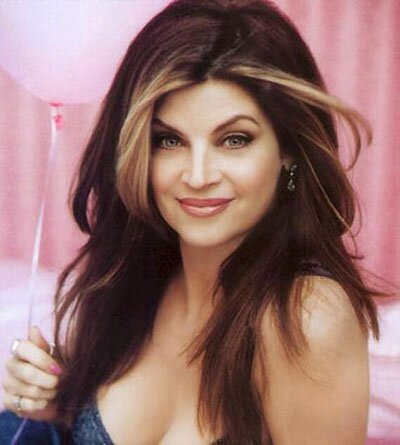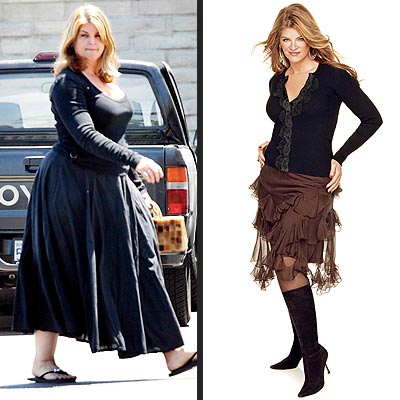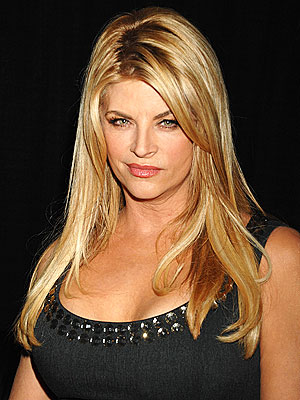Kirstie Alley Movies Biography
The downward drift in Kirstie Alley's career - some cynics would say, her physiognomy - was never more evident than when she starred in the cable TV series, "Fat Actress" (Showtime, 2005). The one-time sexy starlet, who had skyrocketed to fame by first playing Lt. Saavik in the classic film "Star Trek II: The Wrath of Khan" (1982), followed by successfully replacing Shelley Long as the neurotic but sympathetic barkeeper Rebecca Howe on the long-running hit TV sitcom "Cheers" (NBC, 1982-1993), was now reduced to playing herself: an overweight, aging actress trying to revive her Hollywood career. It was a bold move on Alley's part to put her all-too-obvious weaknesses on TV for the world to see. The problem was, nobody wanted to see it. "Fat Actress" was panned by critics and cancelled after just one season. To her credit Alley - a convert to the controversial religion of Scientology - did what she always did when faced with adversity - including drug addiction and divorce - she shrugged it off and prospered, signing a lucrative deal to be a spokeswoman for the Jenny Craig weight-loss program. It was this reliability to the common woman - to say nothing of her incredible self-deprecating humor - which solidified her appeal to fans and a press which now forgave her anything.
Kirstie Louise Alley was born Jan. 12, 1951, in Wichita, KS. She lived a typical Middle American childhood. Her father Robert owned a lumber company and her mother Lillian was a homemaker to her and her two siblings. After finding her niche as cheerleader while in high school, she tried college, dropping out of both Kansas State University and the University of Kansas before deciding what she really wanted to do was act. She moved to Los Angeles in the early 1970s, working as an interior decorator, while at the same time, going out on auditions, albeit with little success. Her social life was another story. Alley ran with a fast Hollywood crowd and became addicted to cocaine. Sick and broke, she found salvation in the Church of Scientology, the cultish religion based on the teachings of L. Ron Hubbard, a former science fiction author. Scientology was at this time becoming popular among a group of young Hollywood actors, eventually attracting movie stars like John Travolta and Tom Cruise to its fold. Alley would forever claim the religion got her off drugs and saved her life. Now clean, she just needed to become a movie star.
Wanting to get noticed and hoping to raise extra cash, she auditioned for game shows. She appeared on "Match Game" (CBS, 1973-1982) in 1979 and "Password Plus" (NBC, 1979-1982) in 1980, impressing producers and the audience with her quick wit and dark girl-next-door good looks. Ironically, neither of these was put to good use when she got her first big break, playing Lieutenant Saavik in the feature film, "Star Trek II: The Wrath of Khan." Makeup artists transformed Alley's wholesome features into the pointy-eared, stone-faced visage of a half-Vulcan, half-Romulan alien, and the director encouraged her to affect the flat Vulcan line readings made famous by Leonard Nimoy's Mr. Spock. Nevertheless, the movie did well - to the point that Trekkies would consider it the best of the "Star Trek" films - and Kirstie Alley could now legitimately call herself a Hollywood actress.
Following her promising breakout role as Saavik, Alley worked steadily in unspectacular projects through the mid-1980s. Besides her work in the acclaimed Civil War-era TV miniseries "North and South" (ABC, 1985), the highlight of this period was her marriage to actor Parker Stevenson in 1983. Stevenson was a handsome, Princeton-educated actor who had gained fame playing boy detective Frank Hardy in "The Hardy Boys/ Nancy Drew Mysteries" (ABC, 1977-79). If Alley's career had not quite taken off, at least her personal life had. All that would change, however, when she was cast as the new bar owner and love interest in "Cheers," following the departure of the beloved Shelley Long and her character, Diane Chambers.
At the time Alley joined the show, "Cheers" was one of the best and most popular sitcoms in television history. The show centered around Sam Malone (Ted Danson), an alcoholic ex-Red Sox pitcher, and the eccentric patrons and staff at Cheers, the bar owned and run by Sam. The rocky romantic chemistry generated between Sam and one of his waitresses, Diane Chambers, drove the show to primetime supremacy and Long to leave for a career in movies. Replacing Long was, well, a long shot, but the show did not miss a beat when Alley assumed the role of Rebecca Howe, the bar's new owner and Sam's eventual love interest. Alley actually appeared in more episodes than Long and helped keep the show a ratings champ and critical darling before it finally went off the air in 1993. She won an Emmy as the Outstanding Lead Actress in a Comedy Series for 1991 and won the Golden Globe as well that same year.
The motto at Cheers was "Everybody knows your name" and now everybody knew who Kirstie Alley was, at long last. She used her TV success as a launching pad into features, starring in the comedy "Look Who's Talking" (1989) with friend and fellow Scientologist John Travolta. The movie got middling reviews but grossed over $100 million, ensuring two sequels - "Look Who's Talking Too" (1990) and "Look Who's Talking Now" (1993). Alley did not abandon TV, however, and won another Emmy for her starring turn as the mother of an autistic boy in the made-for-TV movie, "David's Mother" (CBS, 1994). She played a social worker in "It Takes Two" (1995), the movie debut of Ashley and Mary-Kate Olson, then moved on to more prestigious fare, earning excellent reviews as a psychiatrist married to Woody Allen's writer character in the film "Deconstructing Harry" (1997).
Alley's career was at its zenith at this time. Unfortunately, her personal life was bottoming out. When Alley won the Emmy in 1991, she thanked her husband in her speech "for giving me the big one for the last eight years." By 1997 he was giving her a divorce. Alley and Stevenson's marriage crumbled under the pressure of her success and his lack of it. "Cheers" had made her rich, and they lived a luxurious lifestyle, complete with multiple homes, yachts, and high-performance cars. Alley allegedly paid Stevenson a settlement of $6 million and agreed to joint custody of their two adopted children. Not a bad deal for Stevenson, whose career highlight after "The Hardy Boys" was playing a beefcake lifeguard on the jiggle-fest beach-and-babes TV drama, "Baywatch" (NBC/ Syndicated 1989-2001).
Alley's physical appearance was changing along with her marital status. By the mid-1990s, she was putting on weight, due to many factors in her life, she would later admit. In an industry obsessed with borderline anorexic thinness, her curvy figure stood out as either a bold declaration of self or slovenly excess. In either case, it did not stop her from getting work initially. After slogging through a few unmemorable TV movies, she hooked up with the powerhouse producing team of Kevin Bright, Marta Kauffman and David Crane, the creators of the TV sitcom smash "Friends" (NBC, 1994-2004). The show they created for Alley was "Veronica's Closet" (NBC, 1997-2000), in which the star played Veronica Chase, the divorced owner of a lingerie company called (surprise!) Veronica's Closet. Just as she had with Rebecca Howe, Alley was once again playing a funny, neurotic career woman - albeit one 10 years older and 30 pounds heavier. "Veronica's Closet" stayed open for business despite bad reviews, mediocre ratings and high production costs, but NBC finally shut the door and cancelled it after three seasons.








The downward drift in Kirstie Alley's career - some cynics would say, her physiognomy - was never more evident than when she starred in the cable TV series, "Fat Actress" (Showtime, 2005). The one-time sexy starlet, who had skyrocketed to fame by first playing Lt. Saavik in the classic film "Star Trek II: The Wrath of Khan" (1982), followed by successfully replacing Shelley Long as the neurotic but sympathetic barkeeper Rebecca Howe on the long-running hit TV sitcom "Cheers" (NBC, 1982-1993), was now reduced to playing herself: an overweight, aging actress trying to revive her Hollywood career. It was a bold move on Alley's part to put her all-too-obvious weaknesses on TV for the world to see. The problem was, nobody wanted to see it. "Fat Actress" was panned by critics and cancelled after just one season. To her credit Alley - a convert to the controversial religion of Scientology - did what she always did when faced with adversity - including drug addiction and divorce - she shrugged it off and prospered, signing a lucrative deal to be a spokeswoman for the Jenny Craig weight-loss program. It was this reliability to the common woman - to say nothing of her incredible self-deprecating humor - which solidified her appeal to fans and a press which now forgave her anything.
Kirstie Louise Alley was born Jan. 12, 1951, in Wichita, KS. She lived a typical Middle American childhood. Her father Robert owned a lumber company and her mother Lillian was a homemaker to her and her two siblings. After finding her niche as cheerleader while in high school, she tried college, dropping out of both Kansas State University and the University of Kansas before deciding what she really wanted to do was act. She moved to Los Angeles in the early 1970s, working as an interior decorator, while at the same time, going out on auditions, albeit with little success. Her social life was another story. Alley ran with a fast Hollywood crowd and became addicted to cocaine. Sick and broke, she found salvation in the Church of Scientology, the cultish religion based on the teachings of L. Ron Hubbard, a former science fiction author. Scientology was at this time becoming popular among a group of young Hollywood actors, eventually attracting movie stars like John Travolta and Tom Cruise to its fold. Alley would forever claim the religion got her off drugs and saved her life. Now clean, she just needed to become a movie star.
Wanting to get noticed and hoping to raise extra cash, she auditioned for game shows. She appeared on "Match Game" (CBS, 1973-1982) in 1979 and "Password Plus" (NBC, 1979-1982) in 1980, impressing producers and the audience with her quick wit and dark girl-next-door good looks. Ironically, neither of these was put to good use when she got her first big break, playing Lieutenant Saavik in the feature film, "Star Trek II: The Wrath of Khan." Makeup artists transformed Alley's wholesome features into the pointy-eared, stone-faced visage of a half-Vulcan, half-Romulan alien, and the director encouraged her to affect the flat Vulcan line readings made famous by Leonard Nimoy's Mr. Spock. Nevertheless, the movie did well - to the point that Trekkies would consider it the best of the "Star Trek" films - and Kirstie Alley could now legitimately call herself a Hollywood actress.
Following her promising breakout role as Saavik, Alley worked steadily in unspectacular projects through the mid-1980s. Besides her work in the acclaimed Civil War-era TV miniseries "North and South" (ABC, 1985), the highlight of this period was her marriage to actor Parker Stevenson in 1983. Stevenson was a handsome, Princeton-educated actor who had gained fame playing boy detective Frank Hardy in "The Hardy Boys/ Nancy Drew Mysteries" (ABC, 1977-79). If Alley's career had not quite taken off, at least her personal life had. All that would change, however, when she was cast as the new bar owner and love interest in "Cheers," following the departure of the beloved Shelley Long and her character, Diane Chambers.
At the time Alley joined the show, "Cheers" was one of the best and most popular sitcoms in television history. The show centered around Sam Malone (Ted Danson), an alcoholic ex-Red Sox pitcher, and the eccentric patrons and staff at Cheers, the bar owned and run by Sam. The rocky romantic chemistry generated between Sam and one of his waitresses, Diane Chambers, drove the show to primetime supremacy and Long to leave for a career in movies. Replacing Long was, well, a long shot, but the show did not miss a beat when Alley assumed the role of Rebecca Howe, the bar's new owner and Sam's eventual love interest. Alley actually appeared in more episodes than Long and helped keep the show a ratings champ and critical darling before it finally went off the air in 1993. She won an Emmy as the Outstanding Lead Actress in a Comedy Series for 1991 and won the Golden Globe as well that same year.
The motto at Cheers was "Everybody knows your name" and now everybody knew who Kirstie Alley was, at long last. She used her TV success as a launching pad into features, starring in the comedy "Look Who's Talking" (1989) with friend and fellow Scientologist John Travolta. The movie got middling reviews but grossed over $100 million, ensuring two sequels - "Look Who's Talking Too" (1990) and "Look Who's Talking Now" (1993). Alley did not abandon TV, however, and won another Emmy for her starring turn as the mother of an autistic boy in the made-for-TV movie, "David's Mother" (CBS, 1994). She played a social worker in "It Takes Two" (1995), the movie debut of Ashley and Mary-Kate Olson, then moved on to more prestigious fare, earning excellent reviews as a psychiatrist married to Woody Allen's writer character in the film "Deconstructing Harry" (1997).
Alley's career was at its zenith at this time. Unfortunately, her personal life was bottoming out. When Alley won the Emmy in 1991, she thanked her husband in her speech "for giving me the big one for the last eight years." By 1997 he was giving her a divorce. Alley and Stevenson's marriage crumbled under the pressure of her success and his lack of it. "Cheers" had made her rich, and they lived a luxurious lifestyle, complete with multiple homes, yachts, and high-performance cars. Alley allegedly paid Stevenson a settlement of $6 million and agreed to joint custody of their two adopted children. Not a bad deal for Stevenson, whose career highlight after "The Hardy Boys" was playing a beefcake lifeguard on the jiggle-fest beach-and-babes TV drama, "Baywatch" (NBC/ Syndicated 1989-2001).
Alley's physical appearance was changing along with her marital status. By the mid-1990s, she was putting on weight, due to many factors in her life, she would later admit. In an industry obsessed with borderline anorexic thinness, her curvy figure stood out as either a bold declaration of self or slovenly excess. In either case, it did not stop her from getting work initially. After slogging through a few unmemorable TV movies, she hooked up with the powerhouse producing team of Kevin Bright, Marta Kauffman and David Crane, the creators of the TV sitcom smash "Friends" (NBC, 1994-2004). The show they created for Alley was "Veronica's Closet" (NBC, 1997-2000), in which the star played Veronica Chase, the divorced owner of a lingerie company called (surprise!) Veronica's Closet. Just as she had with Rebecca Howe, Alley was once again playing a funny, neurotic career woman - albeit one 10 years older and 30 pounds heavier. "Veronica's Closet" stayed open for business despite bad reviews, mediocre ratings and high production costs, but NBC finally shut the door and cancelled it after three seasons.
Kirstie Alley Movies

Kirstie Alley Movies

Kirstie Alley Movies

Kirstie Alley Movies

Kirstie Alley Movies

Kirstie Alley Movies

Kirstie Alley Movies

Kirstie Alley Movies

Kirstie Alley Movies
All Kirstie Alley's Movies And Shows
Kirstie Alley shoplifts & Scams With Her Daughter In TV Movie
No comments:
Post a Comment